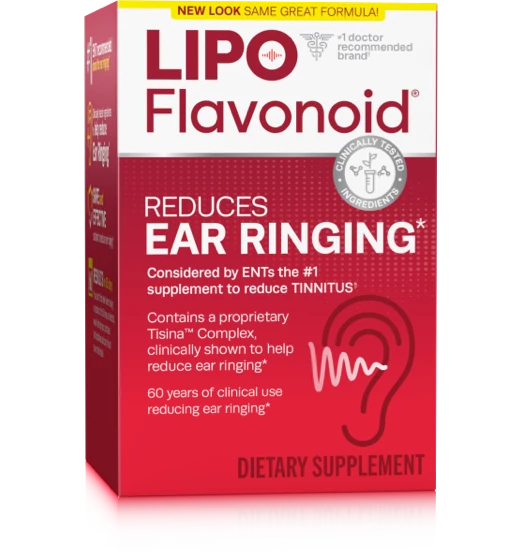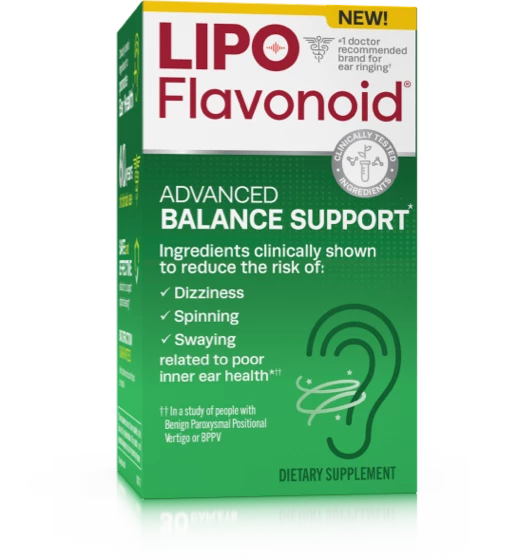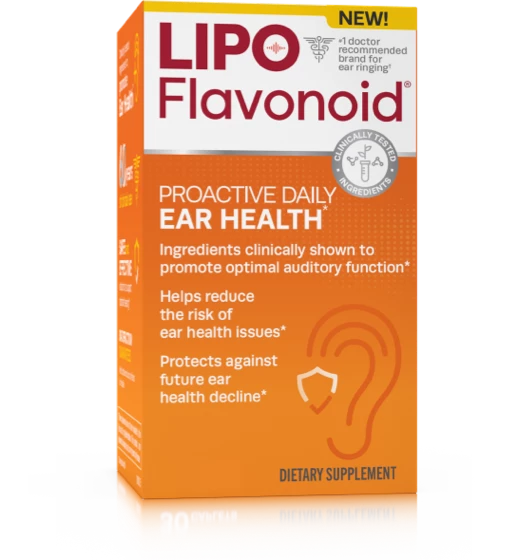- Products
- Science
-
Resources
- Tinnitus Resources
- What is tinnitus?
- Causes of tinnitus
- Tips for managing tinnitus
- Prepare for your doctor's visit
- PTSD and tinnitus
- Tinnitus FAQs
- Hearing Loss Resources
- What is hearing loss?
- Degrees of hearing Impairment
- Types of hearing loss
- Causes of hearing loss
- Treatment options for hearing loss
- Buy Now
- Coupons
- Test Your Hearing
- Test Your Hearing
- Healthcare Professionals
How Does Lipo-Flavonoid® Plus Work?
About 20% of all adults in the United States suffer from tinnitus or ringing in the ears.1
But, as you probably know, ringing in the ears is so much more than just ringing.
For at least 2 million Americans, “phantom” noises in the ears make it nearly impossible to function normally in day-to-day life.2
Whether the distressing sounds are ringing, buzzing, humming, grinding, or whooshing, people who suffer from tinnitus also often experience hearing loss, anxiety, depression, difficulty concentrating, insomnia, and social problems.3,4
Given these serious effects and the large numbers of people experiencing tinnitus, it’s important that we get word out about potential tinnitus management strategies.
One of these is nutritional supplementation with lemon bio-flavonoids and other key nutrients, like those in Lipo-Flavonoid® Plus.
Flavonoid compounds are believed to have anti-viral, anti-inflammatory, anti-oxidant, and anti-platelet effects.5,6Lemon bio-flavonoids (specifically bioflavonoid eriodictyol glycoside) have been used to treat tinnitus since the 1960s, when a prominent ear nose and throat specialist (an ENT physician) with the Mayo Clinic in Minnesota first described their successful use.7 Today, Lipo-Flavonoid® Plus combines lemon bio-flavonoids with other essential nutrients to help support ear health. Clinical experience reported in medical literature8-13 indicates that patients can experience considerable benefit from lemon bio-flavonoidswithout side-effects.13
Lemon bio-flavonoids are thought to help relieve tinnitus symptoms by:
- Improving microcirculation in the inner ear8,14
- Preventing abnormal accumulation of fatty deposits6,14
- Blocking histamine production in the inner ear, a likely cause of inner ear disturbances10
In a 2016 survey of 250 ENTs, each said they recommend nutritional supplements for patients presenting with tinnitus or Meniere’s disease (an inner ear disorder that causes tinnitus, vertigo, and hearing loss.15) And, 85% said that Lipo-Flavonoid® is the brand they recommend the most.16
How do you use Lipo-Flavonoid®?
Initially, the recommended dose is two caplets three times a day (in the morning, at midday and in the evening adding up to six total caplets per day.) This dosing should be continued for 60 days or until symptoms improve. Then the maintenance regimen can begin. For maintenance, take one caplet three times a day (in the morning, at midday, and in the evening adding up to three total caplets per day).
If you don’t find relief from ringing in the ears after taking Lipo-Flavonoid® Plus as directed for 60 days, Clarion Brands will refund your money.
Of course, prior to starting any supplement or therapy, it is important to have a thorough medical examination and evaluation, in this case by your otolaryngologist (ENT doctor) or audiologist.
Sometimes tinnitus can be caused by a physical blockage in the ear (such as ear wax), as a side effect of starting or stopping a different medication, or by a separate medical condition.
Only your doctor can help you find out what is causing your tinnitus and how best to manage it. Prepare for your appointment by:
- Making a list of all the over-the-counter, prescription, and herbal products you take
- Keeping a tinnitus diary including symptoms, severity, day-to-day effects, and potential triggers
- Printing information about Lipo-Flavonoid® Plus so you can discuss its potential role in your ear health.
Learn more at LipoFlavonoid.com.
References:
- Tinnitus Overview. Mayo Clinic website http://www.mayoclinic.org/diseases-conditions/tinnitus/basics/definition/con-20021487. Accessed Sept. 7, 2016.
- Understanding the Facts. American Tinnitus Associations website https://www.ata.org/understanding-facts. Accessed Sept. 7, 2016.
- Han B, Lee H, Kim T, et al. Tinnitus: Characteristics, Causes, Mechanisms, and Treatments. Journal of Clinical Neurology (Seoul, Korea). 2009;5(1):11-19. doi:10.3988/jcn.2009.5.1.11.
- Altissimi G, Salviati M, Turchetta R, et al. When Alarm Bells Ring – Tinnitus. Eur Rev Med Pharmacol Sci. 2016 Jul;20(14):2955-73.
- Ishikawa Y, Kitamura M. Bioflavonoid quercetin inhibits mitosis and apoptosis of glomerular cells in vitro and in vivo. Biochem Biophys Res Commun 2000, 279(2):629-34.
- Kumar S, Pandey AK. Chemistry and Biological Activities of Flavonoids: An Overview. The Scientific World Journal. 2013;2013:162750. doi:10.1155/2013/162750.
- Williams H, Hedgecock L. Citrus Bioflavonoids, Ascorbic Acid and Other B-vitamins in the Treatment of certain types of neurosensory deafness a preliminary report. Staff meeting of the Mayo Clinic (1962).
- Otolaryngologic Clinics of North America 1997; 30:1027-37.
- Am J Otol 1996; 17:529-36.
- Arenberg I, Bayer R. Therapeutic Options in Meniere’s Disease. Arch Otolaryngol 1977;103: 589-93.
- Shaia F, Sheehy J. Sudden sensori-neural hearing impairment: a report of 1,220 cases. Laryngoscope 1976; 86:389-98.
- Herschberg S. Meniere’s disease. J Am Osteopathic Association 1974; 73:540-6.
- Wolfson R. Treatment of Meniere’s disease. Modern Treatment (1969) 6,3, 553-567.
- Rubin W. Vestibular suppressant drugs. Arch Otolaryngol 1973; 97:135-8
- Menieres Disease Definition. Mayo Clinic website http://www.mayoclinic.org/diseases-conditions/menieres-disease/basics/definition/con-20028251. Accessed Sept. 7, 2016.
- April 2016 Survey. Clarion Brands Inc. Data on file.
*These statements have not been evaluated by the Food and Drug Administration. These products are not intended to diagnose, treat, cure or prevent any disease.
*Survey data on file
REFERENCES:
- April 2018 Survey. Clarion Brands Inc. data on file.
- Williams H, Hedgecock L. Citrus Bioflavonoids, Ascorbic Acid and Other B-vitamins in the Treatment of certain types of neurosensory deafness a preliminary report. Staff meeting of the Mayo Clinic (1962).
- Tinnitus Overview. Mayo Clinic website http://www.mayoclinic.org/diseases-conditions/tinnitus/basics/definition/con-20021487. Accessed Sept. 7, 2016.
- Understanding the Facts. American Tinnitus Associations website https://www.ata.org/understanding-facts. Accessed Sept. 7, 2016.
- Slattery WH, Fayad JN. Medical treatment of Meniere's disease. Otolaryngologic Clinics of North America 1997; 30:1027-37.
- Kumar S, Pandey AK. Chemistry and Biological Activities of Flavonoids: An Overview. The Scientific World Journal. 2013;2013:162750. doi:10.1155/2013/162750.
- Fetterman BL, Saunders JE, Luxford WM. Prognosis and treatment of sudden sensorineural hearing loss. Am J Otol 1996; 17:529-36.
- Arenberg I, Bayer R. Therapeutic Options in Meniere’s Disease. Arch Otolaryngol 1977;103: 589-93.
- Shaia F, Sheehy J. Sudden sensori-neural hearing impairment: a report of 1,220 cases. Laryngoscope 1976; 86:389-98.
- Herschberg S. Meniere’s disease. J Am Osteopathic Association 1974; 73:540-6.
- Wolfson R. Treatment of Meniere’s disease. Modern Treatment (1969) 6,3, 553-567.
- Rubin W. Vestibular suppressant drugs. Arch Otolaryngol 1973; 97:135-8




